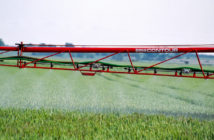Cereals growers should persevere with their autumn grassweed control programmes to achieve the cleanest fields and the best chance of strong yields.
Dow AgroSciences says growers are easily deterred from herbicide applications during the autumn months by short days, fluctuating temperatures and a lack of dry leaf.
But research carried out by the company continues to show that for sterile brome control and ryegrass, the best results in terms of both weed control and crop yield are achieved by spraying in the autumn.
Stuart Jackson, cereals herbicide specialist for Dow, says there are two principle reasons for this.
He said: “Firstly, herbicides are more effective when applied to small weeds. Control of sterile brome, for example, is compromised when growth reaches beyond four tillers and the result is more likely to be a stunted plant.
“Secondly, autumn soils hold warmth which promotes active growth in the weeds – a requirement for ALS herbicides to perform. If left until the spring, soils take longer to warm up following winter and can hold back growth even though air temperatures may be suitable.”
Mr Jackson acknowledges the difficulties that the weather presents during the autumn months and advises growers to prioritise in order to achieve the best results.
“Treating fields sown before mid-October, those with high weed pressure and sites where growers have experienced poor control in the past should be top of the list,” he says.
“Those sown using min-till techniques and with difficult ryegrass populations should also be a major focus if there is limited time available to carry out applications.
“Fields that have had a residual top up and those with no known resistant populations can be left until later if time allows.”
Product choice remains important and Mr Jackson reminds growers that it is important that pyroxsulam plus florasulam products should be used as part of a programme with other residual herbicides such as pendimethalin and flufenacet for best results.




